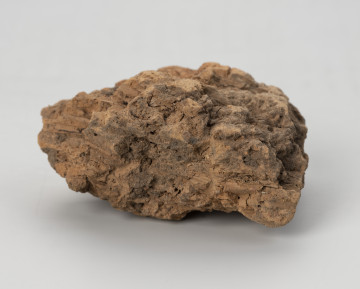
Polepa (daub)
700 — 1250
National Museum in Szczecin
Part of the collection: Craft and industry products of Szczecin
The technological advancements in the production of building materials during the mid-19th century and the resulting increase in demand for various ceramic materials contributed to the establishment of brickworks and industrial plants, including those in Pomerania. In Podjuchy, near Szczecin, Friedrich Ferdinand Didier (1801–1867) founded Germany’s first refractory materials factory in 1834. Didier, a Szczecin native of French descent, trained as a merchant and gained industry experience working at a brickworks in Rostock. After his father’s death, he moved with his sister to Podjuchy, where he purchased a medieval-era brickworks and lime kiln, establishing the Chamotte-und Gasretorten-Fabrik, Kalkbrenerei, Ziegelei in Podejuch. The factory’s production relied on local raw materials – gravel and quartz sand deposits discovered by Didier himself in the moraine hills of the Bukowe Hills. The main customer of the brickworks was the Szczecin gasworks in Pomorzany (Stettiner Gaswerke). Over time, Didier formed a partnership with the gasworks’ director and municipal councillor, Wilhelm Kornhardt, which led to the establishment of a new refractory materials factory between 1864 and 1865, located next to the gasworks at Schwarzer Damm 13a. The Chamottefabrik F. Didier produced between 8,000 and 10,000 firebricks annually, which were exported to Prussia, the Kingdom of Poland, and even Austria-Hungary. After Didier’s childless death and Kornhardt’s death in 1871, the new owners converted the business into a joint-stock company in 1872, naming it Stettiner Chamotte-Fabrik AG, vormals Didier. In 1925, the company's headquarters moved to Berlin, and in 1937, it was renamed Didier-Werke AG. After World War II, the company was re-established in Wiesbaden, and in 1995, it was acquired by the Austrian firm RHI AG. The Museum of the History of Szczecin holds a collection of five chamotte bricks bearing the DIDIER mark. Due to their refractory properties, such bricks are still used today in fireplaces, kitchen stoves, masonry heaters, and bakery ovens. Małgorzata Peszko
Technique
firing
Origin / acquisition method
donation
Creation time / dating
Creation / finding place
Owner
The National Museum in Szczecin
Identification number
Location / status

700 — 1250
National Museum in Szczecin

1929 — 1945
National Museum in Szczecin

2nd half of the 19th century
Castle Museum in Łańcut
DISCOVER this TOPIC
National Museum in Lublin
DISCOVER this PATH
Educational path